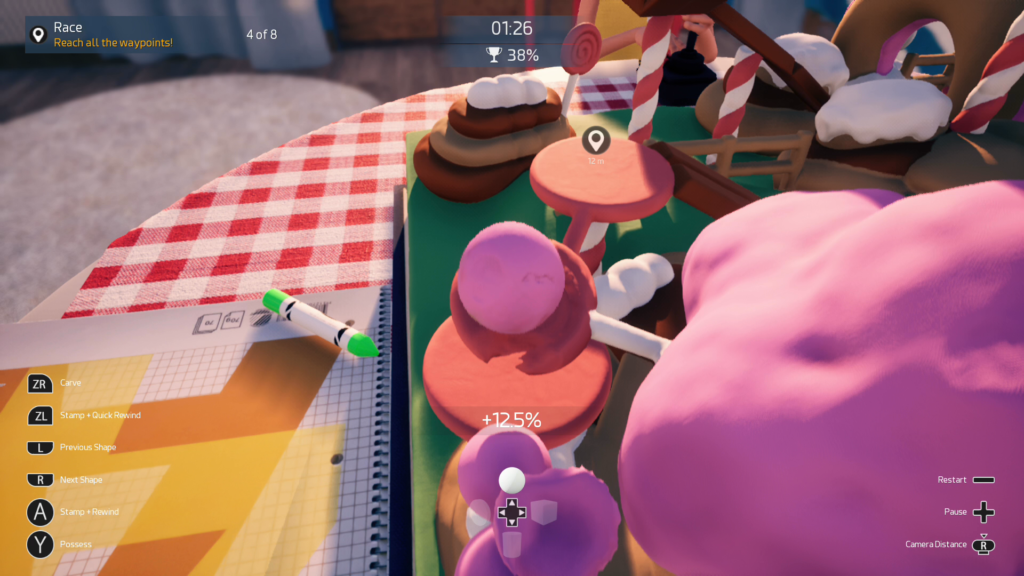Clay is an interesting medium to work with. Dependent on what you are doing with it, it can be unforgiving. For example: a kindergartener can learn to make a cute turtle, using their shoe treads to create the shell patterns, filling them with awe and wonder. Meanwhile, a grown man can weep at a pottery wheel with a similar lump of earth as it collapses in on itself… or as it turn into one of the jankiest pieces of pottery ever conceived. I will leave you to guess which one was my experience. If prepared properly, clay can put form to the artist’s imagination and skill, as does the ambition of today’s game in review. This is our review of Claybook on Nintendo Switch.
Claybook is an invitation into a world of creation and imagination where everything is made of clay. With this malleable mud, you will solve puzzles and complete goals with a variety of shapes including (but certainly not limited to) cubes, spheres, cylinders, and disks. These goals are specific to each level. One level may have you filling pools by creating trenches to lead the liquid to them while another acts as an obstacle course. There are also objects like giant donuts or ducks which you can possess to help you achieve your goals more efficiently. How you complete these tasks is up to you!

Since everything within the world is made out of colorful clay, your shapes and the landscape are impacted by their collision with one another. You also have the option to use your shape to carve into the landscape. It is definitely an interesting mechanic, but this can cause some major issue traversing levels. Fortunately, there is a rewind mechanic that allows you to leave your shape in its current location while staring with a fresh piece further back in your adventures.
Claybook consists of twenty levels broken up into with five different themes, or books. Each level contains a star rating system, but it does not do a very good job of explaining just how you can improve your rating. I had to go digging to discover that each star represents a level of completion on the level’s objective. You will receive one star at 50%, 75%, and one at 100%. However, there were some levels that this felt inconsistent.
Since levels are gated behind how many stars you have earned, advancing through the books takes a lot of trial and error. There were levels where I attempted multiple runs and completed with better times or cleaner victories in the goals, but found myself with scores too low to advance any farther. As it turns out, I was so focused on time ticking away that it was easy to mistake it as the overall important factor versus the art of completing the challenges.

This is where Claybook has me stumped.
I really want to like this experience. It has a vibrant, serene quality to it that makes it stand out amongst its overly-caffeinated peers in the indie games arena. It has many of the trappings that I look for in a puzzler – it’s unique, provokes wonder, and presents a challenge, but it doesn’t draw me back into the experience. While each level I experienced had interesting goals, the timer fed me an illusion of urgency when all I really needed to do was enjoy the world I was creating (and destroying) in.
Being married to an elementary art teacher, I have often heard that art should be fun. That is not to say that art is always easy, nor will everyone produce fine art. However, studying art should always instill a joy for creation and discovery in the learner. As an artist grows in these areas, they can build a stronger foundation and toolbox of honed skills. These qualities cannot be rushed.

Using clay as the main gameplay medium should be fun and inspiring as it is whimsical, but the chaos it creates with the leaderboard clock and destructible levels remove too much from what it is trying to achieve. While there is a sandbox mode for each level, Claybook just does not instruct the player well enough to get their feet under them at the beginning. This level of expectation of the player is not unlike a teacher expecting students at the beginning of a school year to perform above the grade level they have just entered.
In the case of Claybook, the clay may just be a bit too unforgiving without proper instructional setup.
Note: Our copy was reviewed on Nintendo Switch with a code provided by PR.
COMPARE TO: Katamari Damacy, Goat Simulator






